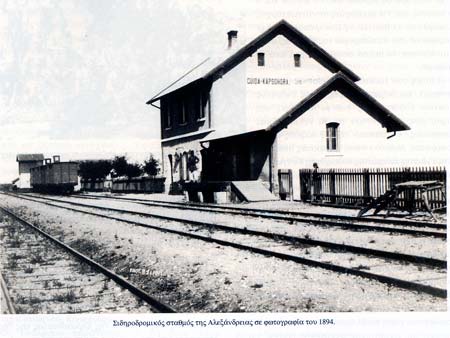
At the end of the 19th century the Ottoman Empire made an agreement with German and Austrian investors about the construction of railways that would help the easier transportation of raw materials and industrial products. The Germans tried to create a railway that would connect Vienna to Thessaloniki through Bosnia. In the context of this try they suggested the construction of a railway that would connect Thessaloniki to Monastiri (Bitola). After a year of conversations the Deutsche Bank of Berlin took over the construction of the railway (27-10-1890) and safeguarded its right to exploit it for 99 years. The contract was signed in 28-10-1890.
According to the agreement the preliminary study of the first part of the railway (Thessaloniki-Veria) should be ready within 6 months and the construction should begin within 15 months. The railway should be ready in 3,5 years and the constructions would be supervised by a committee appointed by the Ottoman government. Despite the higher cost the gauge of the railway was of 144 cm. instead of 100 cm. in order to connect the local railway network to the European one.
The average cost was 113.000 francs per kilometer, an amount that included the costs of the preliminary study, the drafts, the expropriations, the building of the railway as well as of the railway stations, the telegraph installation and the substructure.
Many technical works were built to assist the construction, as the geographical characteristics and the climate made it hard for the workers. The building of the railway started in Thessaloniki. From the 28,5th km. until the station of Alexandreia (Guida) there were three bridges; one of them had a span of 72m. From the station of Alexandreia on the way to the station of Veria (Karaferia) there were twelve bridges with a total span of 200m. From the station of Veria on the way to the station of Naoussa (Agoustos) there were three more bridges.
The company also paid for the buildings of the stations with the exception of those in Thessaloniki. The stations were in: Thessaloniki, Sindos (Tekeli), Adendro (Kirtzalar), Alexandreia (Gidas), Veria (Karaferia), Naoussa (Agoustos), Skydra (Vertekop).
The company expropriated land and compensated the landowners with money that reached even to 6, 67 golden coins per square meter. Especially in 1892, the landowners asked for too much money in order to give their land. The exploitation of the railway was assigned to the “Compagnie d’ Exploitation des Chemins de fer orientaux “.
The first part of the 97 km. railway, whose inauguration took place in 9-12-1892, connected Thessaloniki to Skydra (Vertekop).
The train left Thessaloniki every day at 06.50 and arrived in Kirtzalar at 08.00, in Guida (Alexandreia) at 08.39, in Karaferia at 09.41, in Agoustos at 10.12 and in Vertekop at 10.49. On its way back it left Vertekop at 12.19 and arrived in Agoustos at 12.52, in Karaferia at 13.28, in Guida at 14.25, in Kirtzalar at 15.04 and in Thessaloniki at 16.09.
The railway of Alexandreia was constructed in 1894, at the same period the railway Thessaloniki-Monastiri was constructed. Due to the Turkish domination on the first station sign is written “GUIDA-KAPSOHORA”. King Goergios the 1st send the telegram about the liberation of the city from this station.
In 1921 the station was recognized as a settlement. In 1920 its inhabitants reached up to 22 persons. Many politicians and military visited this station and in 1933 telephone and post-offices were created there.
During the Civil War the bridge of Kouloura was destroyed and the passengers were transferred to Agras by bus. Finally, the settlement became a part of the city of Alaxandreia. The building of the station hasn’t changed at all since it was built.
It is worth to mention that the plane-tree next to the station is over 100 years old.
Dimitrios Bellos,
ALEXANDREIA, THE RAILWAY AND THE CITY 1894-1994